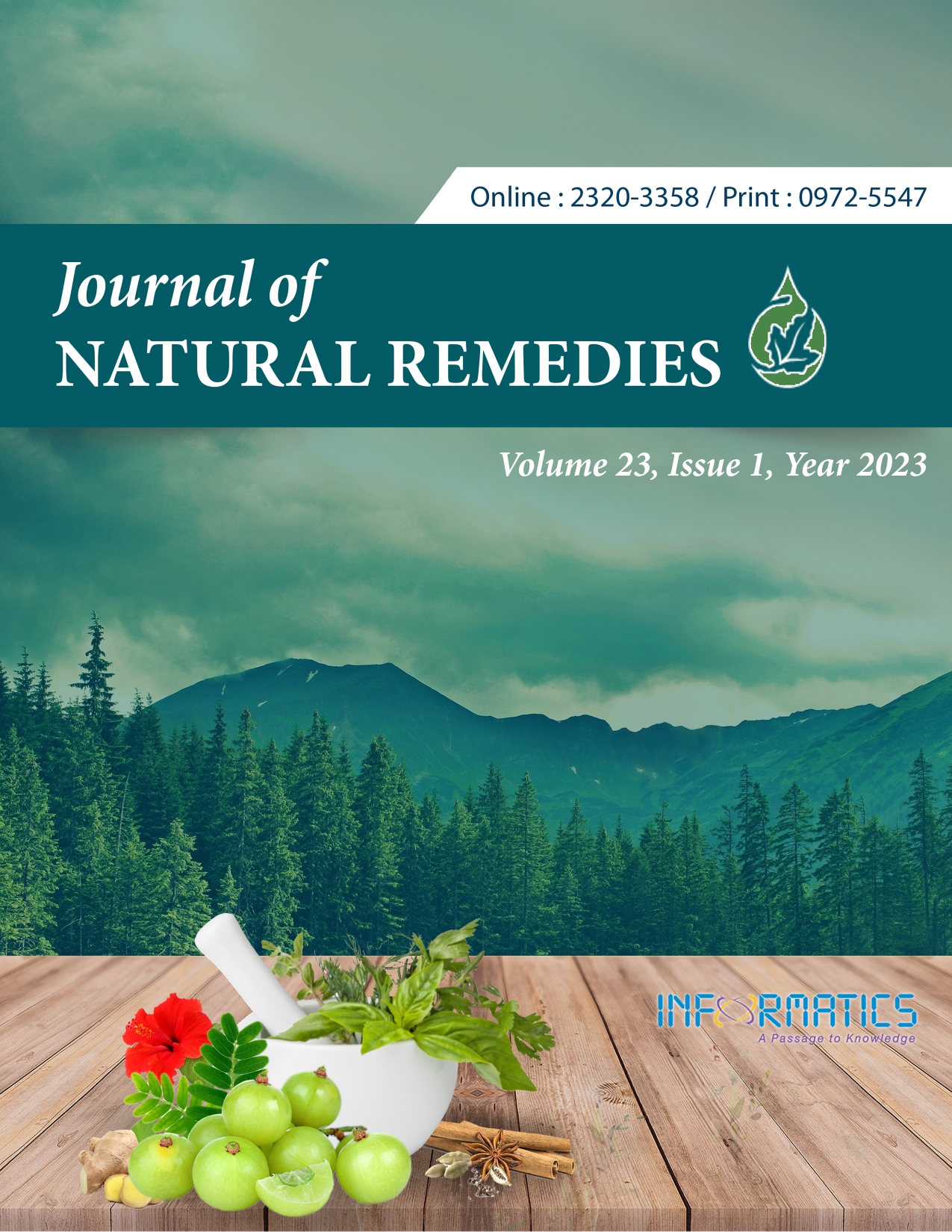Estimation of Digoxin in Chloroform Extract of Moringa concanensis Leaves Using Newly Developed and Validated RP-HPLC Method
DOI:
https://doi.org/10.18311/jnr/2023/31352Keywords:
Chloroform Extract, Moringa concanensis, RP-HPLC Method, Soxhlet Extraction.Abstract
Cardiac glycosides are the secondary metabolites that are used in atrial fibrillation and atrial flutter as it binds with the sodium-potassium ATPase pump and increases the force of contraction. There are two types of cardiac glycosides i.e. cardenolides and bufadienolides. Digoxin is a cardenolide type of cardiac glycoside. Digoxin is found in chloroform extract of Moringa concanensis leaves. In the present study, the reverse-phase high-performance liquid chromatography (RP-HPLC) method was developed and validated to determine the content of digoxin in chloroform extract of M. concanensis leaves from three different geographical sources. The chromatographic method was developed at 220 nm wavelength with an Acetonitrile: Water: 1% Orthophosphoric acid (50:50:0.1 %V/V/V) mobile phase. In this method, the digoxin shows linearity in the range of 10 – 50 μg/ml with a regression coefficient of 0.995. The Limit of detection (LOD) and Limit of quantitation (LOQ) was found to be 0.232 μg/ml and 0.703 μg/ml respectively.
Downloads
Metrics
Downloads
Published
How to Cite
Issue
Section
License
Copyright (c) 2023 Tanvi Tanvi, Vaishali Patil (Author)

This work is licensed under a Creative Commons Attribution 4.0 International License.
Accepted 2023-03-23
Published 2023-03-23
References
https://medlineplus.gov/ency/article/002581
https://pubchem.ncbi.nlm.nih.gov/source/hsdb/214
Aronson JK, editor. Meyler’s side effects of drugs: the international encyclopedia of adverse drug reactions and interactions. Elsevier. 2015.
Chaudhuri AB. Endangered medicinal plants. Daya Books. 2007.
Aslam MS, Ahmad MS. Worldwide importance of medicinal plants: current and historical perspectives. Recent Advances in Biology and Medicine. 2016; 2(2016):909. DOI: https://doi.org/10.18639/RABM.2016.02.338811
Ramawat KG, Merillon JM. Bioactive molecules and medicinal plants. Berlin: Springer. 2008. https://doi. org/10.1007/978-3-540-74603-4 DOI: https://doi.org/10.1007/978-3-540-74603-4
Sahoo N, Manchikanti P, Dey S. Herbal drugs: standards and regulation. Fitoterapia. 2010; 81(6):462- 71. https://doi.org/10.1016/j.fitote.2010.02.001 DOI: https://doi.org/10.1016/j.fitote.2010.02.001
Kiran U, Khan S, Mirza KJ, Ram M, Abdin MZ. SCAR markers: a potential tool for authentication of herbal drugs. Fitoterapia. 2010; 81(8):969-76. https://doi. org/10.1016/j.fitote.2010.08.002 DOI: https://doi.org/10.1016/j.fitote.2010.08.002
Ekka NR, Namdeo KP, Samal PK. Standardization strategies for herbal drugs-an overview. Research Journal of Pharmacy and Technology. 2008; 1(4):310-2.
Ahmad I, Aqil F, Owais M, editors. Modern phytomedicine: Turning medicinal plants into drugs. John Wiley and Sons. 2006. https://doi. org/10.1002/9783527609987 DOI: https://doi.org/10.1002/9783527609987
Sarker SD, Nahar L. An introduction to natural products isolation. In Natural products isolation. Humana Press. 2012; pp. 1-25. https://doi. org/10.1007/978-1-61779-624-1_1 DOI: https://doi.org/10.1007/978-1-61779-624-1_1
Khandelwal K. Practical pharmacognosy. Pragati Books Pvt. Ltd. 2008.
Vaishali Patil, Dodiya T. Pharmacognostic, Phytochemical and Nutritional Profile of Moringa concanensis Leaves. International Journal of Ayurvedic Medicine. 2022; 13(1):55–60. https://doi. org/10.47552/ijam.v13i1.2300 DOI: https://doi.org/10.47552/ijam.v13i1.2300
Milenkovic MZ, Marinkovic VD, Sibinovic PS, Palic RM, Milenovic DM. An HPLC method for the determination of digoxin in dissolution samples. Journal of the Serbian Chemical Society. 2010; 75(11):1583-94. https://doi.org/10.2298/ JSC100106123M DOI: https://doi.org/10.2298/JSC100106123M
Megha S, Neeraj M. Development and validation of stability indicating a RP-HPLC method for determination of βacetyldigoxin. Int J Appl Pharm. 2017; 9:54-9. https://doi.org/10.22159/ ijap.2017v9i1.16076 DOI: https://doi.org/10.22159/ijap.2017v9i1.16076
Jedlička A, Grafnetterová T, Miller V. HPLC method with UV detection for evaluation of digoxin tablet dissolution in acidic medium after solid-phase extraction. Journal of pharmaceutical and biomedical analysis. 2003; 33(1):109-15. https://doi.org/10.1016/ S0731-7085(03)00226-7 DOI: https://doi.org/10.1016/S0731-7085(03)00226-7
Todorovic ZB, Lazic ML, Veljkovic VB, Milenovic DM. Validation of an HPLC-UV method for the determination of digoxin residues on the surface of manufacturing equipment. Journal of the Serbian Chemical Society. 2009; 74(10):1143-53. https://doi. org/10.2298/JSC0910143T DOI: https://doi.org/10.2298/JSC0910143T

 Tanvi Dodiya
Tanvi Dodiya









 0.35
0.35 24
24 0.161
0.161